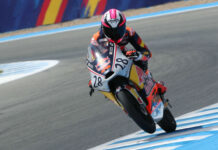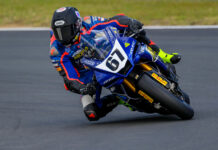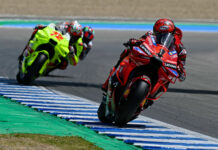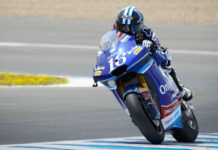From a press release:
DUCATI CORSE PRESS INFORMATION
INTERVIEW WITH DUCATI TECHNICAL DIRECTOR PREZIOSI ON DESMOSEDICI ENGINE
In this copyright-free interview, we have a chat with the man behind the new Desmosedici engine, which will power Ducati’s attack on the MotoGP championship – Filippo Preziosi, Ducati Corse Technical Director.
THE DESMOSEDICI IS A COMPLETELY NEW ENGINE. HOW COME YOU DESIGNED A NEW ENGINE WHEN WITH THE CURRENT ‘TESTASTRETTA’ YOUR RIDERS HAVE LAPPED AT TIMES SIMILAR TO 500 GP BIKES IN MANY CIRCUITS?
As the winter tests are demonstrating, with riders on the new four-stroke prototypes already setting record times, the new regulations offer the possibility of building bikes that are much faster than the 500cc two-strokes. Our Testastretta engine, in a bike weighing 135 kg, would for sure have been as competitive as the 500s, but would just not have had the power required to compete with the new multi-cylinder four-stroke prototypes.
Our twin-cylinder engines, with which we race and will continue to race in Superbike, are capable of producing an incredible amount of power – the 2002 version of the Testastretta produces almost 190 HP at 13,000 rpm – but we didn’t think this was sufficient to compete in MotoGP.
It is the regulations that define the ideal solutions for each category: they do not define what the overall best engine is, but the best engine in view of the limitations imposed.
When Formula 1 regulations changed to allow turbos, normally-aspirated engines disappeared. This does not mean that the best engine around was a turbo, simply that it was for those particular regulations.
So now in MotoGP, we think that a twin-cylinder engine, which the regulations only give a 10 kg weight advantage over the four and five cylinder units, is not the best configuration. In our opinion it continues to be the best layout in Superbike and for road use, but not in a category where maximum power is vitally important in order to be competitive.
WHAT CHARACTERISTICS MAKE THE DESMOSEDICI A TYPICAL DUCATI ENGINE?
The V90° layout with an almost horizontal front cylinder bank, which we call ‘L’, the desmodromic timing system and the Twinpulse effect make the Desmosedici a typical Ducati engine. We designed it starting from a clean sheet of paper, not only in view of the demands of power output and delivery, but above all with one eye on the position of the engine in the bike which has been developed in parallel. There is not one piece of the new engine that has not been designed with the functions of all the other components in mind.
The characteristics of the Ducati engines that we have maintained have major advantages: for example, the ‘L’ layout and the short stroke of the Desmosedici have allowed us to build a small engine in both height and length, making it easier to position in the frame.
The ‘L’ also has another major plus point in the intrinsic balance of the 90° layout of its two cylinder banks, something that is fundamental in an engine that must arrive at 18,000 rpm. The vibration level is in fact reduced to a minimum, with positive effects on mechanical efficiency and reliability.
WHY DID YOU CHOOSE THE DESMO SYSTEM?
The design of the Desmosedici did not start from preconceived ideas. We decided to adopt the desmodromic system after careful analysis had convinced us once again of the validity of this solution. In fact this system has a much lower power loss, in particular in the low and mid-range, than any other timing system and in particular pneumatic valves.
With the aim of maximum engine efficiency in mind, the Desmo therefore allows a significant competitive advantage to be obtained. Furthermore it gives extremely high valve lift values, a necessary condition for maximum performance and finally the Desmo allows high rev levels to be obtained without necessarily running into the complications, costs and reliability problems of pneumatic valve timing.
WHAT DIFFERENCES ARE THERE BETWEEN THE NEW DESMO AND THE ONE IN THE TESTASTRETTA ENGINE?
The Desmosedici has been designed with the same criteria, the same calculation methods and the same experimental methodology with which the Testastretta was designed. The new engine’s desmo uses a solution that we defined for the construction of the Testastretta: placing the closing rockers between the valves and moving the opening ones to the outside. The two engines are therefore linked by having an extremely short valve angle, incompatible with the rocker layout characteristic of the Desmoquattro (four-valve Desmo).
CAN YOU EXPLAIN HOW THE TWINPULSE WORKS?
Although it has four pistons, the Twinpulse maintains the typical characteristics of a twin-cylinder engine. Unlike a conventional four-cylinder unit, which has four distinct combustions for each complete cycle – that is, two turns of the crankshaft – the Twinpulse only has two. This is obtained by simultaneous combustion in the two cylinders of the same bank. The effect, which we have called Twinpulse, cannot be obtained by a four-cylinder engine by simply changing the firing order; it is necessary to design the entire engine with this function in mind, because many internal organs, which are stressed in a different and more ‘traumatic’ way, must be built to the right size.
CAN THE DESMOSEDICI BE CONSIDERED AN EXTREME VERSION OF THE TESTASTRETTA?
The evolution of Ducati engines has meant that in time we have succeeded in combining the advantages of the twin-cylinder engine with the smooth power delivery of a short-stroke engine. Today the twin-cylinder 998R has the same stroke as the four-cylinder Yamaha R1 engine for example.
Between 1994 and today, in the constant search for maximum performance, the stroke value of 66mm on the 916 has been reduced to 58.4mm on the new 998R. From 140HP we have arrived at almost 190 in nine years! In order to obtain even higher power output, we would have had to reduce the stroke value even more, and as a result increase the bore size to a value that would be critical for efficient combustion.
We have continued with the reduction of the stroke value and ‘doubled’ the pistons simply to avoid the combustion problems we spoke about before. For this reason the Desmosedici is an extreme version of a twin-cylinder Ducati.
WILL ELECTRONICS HAVE AN IMPORTANT PART IN THE ENGINE?
We think that electronics will certainly have an important role. Ducati has always believed in the potential of electronics and for well over ten years now our racing bikes have been fitted with electronic injection. As a result we have a lot of experience in this field, which will certainly come in useful. However it is impossible to say now what sort of other electronic devices will be present on the bike. Technical evolution will be continuous but I can say for sure that only electronic devices that prove to be valid and reliable in track testing will be used.
DO YOU THINK THAT FUEL CONSUMPTION WILL BE AN IMPORTANT FACTOR IN MOTOGP?
In our opinion fuel consumption will be fundamental and for this reason we have designed the Desmosedici not only with the aim of having maximum power, but also maximum performance. Ducati has also had a lot of experience in this field and our engines are famous for being amongst the most ‘economical’ in terms of consumption, with performance being equal. Together with Magneti Marelli we are developing a brand-new CPU engine management system, which will make a major contribution to fuel consumption. We can also count on the experience in high-performance engine fuels of our partner Shell, and this will be important in order to achieve the best possible results.
HOW IMPORTANT WAS THE KNOW-HOW ACCUMULATED IN SUPERBIKE OVER THE YEARS IN THE DESIGN OF THE DESMOSEDICI?
It was very important. The experience in Superbike has been useful in the formation of the team of people who designed the Desmosedici. Continuity in fundamental technical decisions like the ‘L’ layout, the Desmo and electronic fuel injection, allowed us to capitalise on this experience.
HOW MANY PEOPLE ARE INVOLVED IN THE DESIGN OF THE DESMOSEDICI AND HOW MANY HOURS HAVE SO FAR BEEN DEDICATED TO THE NEW ENGINE?
At present in Ducati Corse there are 16 people, including engine designers and those involved with fluid-dynamics and structural calculations, as well as Claudio Domenicali and myself. We have succeeded in rapidly developing the new engine thanks also to the support of HPE High Performance Engineering of Modena, the engine design and consultancy firm headed by Piero Ferrari. For the past few months two of their designers have been working side-by-side with us at Borgo Panigale. So far all of these people have passionately dedicated around 19,000 hours to the design of the Desmosedici.
SO WHAT IS THE DESMOSEDICI’S SECRET WEAPON?
The people who designed it! The guys coordinated by Leonardo Mossali – all Italians with an average age of 28, all crazy about bikes and engines, who since the start of the project have been realising their dream of building an engine with which we want to compete in the highest form of motorcycle racing. A team that has worked as a team, that has seen the birth of this engine and that now is dying to see it compete on the track with all the other manufacturers.
Ducati Technical Boss Talks About MotoGP Four-stroke
Ducati Technical Boss Talks About MotoGP Four-stroke
© 2002, Roadracing World Publishing, Inc.






